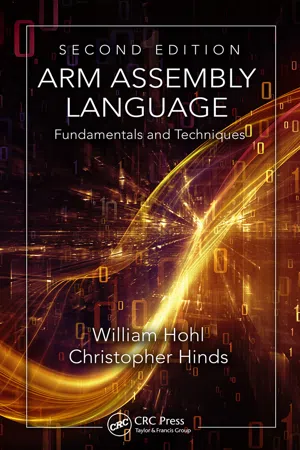
eBook - ePub
ARM Assembly Language
Fundamentals and Techniques, Second Edition
William Hohl, Christopher Hinds
This is a test
Condividi libro
- 453 pagine
- English
- ePUB (disponibile sull'app)
- Disponibile su iOS e Android
eBook - ePub
ARM Assembly Language
Fundamentals and Techniques, Second Edition
William Hohl, Christopher Hinds
Dettagli del libro
Anteprima del libro
Indice dei contenuti
Citazioni
Informazioni sul libro
Delivering a solid introduction to assembly language and embedded systems, ARM Assembly Language: Fundamentals and Techniques, Second Edition continues to support the popular ARM7TDMI, but also addresses the latest architectures from ARM, including Cortex-A, Cortex-R, and Cortex-M processors-all of which have slightly different instruction sets, p
Domande frequenti
Come faccio ad annullare l'abbonamento?
È semplicissimo: basta accedere alla sezione Account nelle Impostazioni e cliccare su "Annulla abbonamento". Dopo la cancellazione, l'abbonamento rimarrà attivo per il periodo rimanente già pagato. Per maggiori informazioni, clicca qui
È possibile scaricare libri? Se sì, come?
Al momento è possibile scaricare tramite l'app tutti i nostri libri ePub mobile-friendly. Anche la maggior parte dei nostri PDF è scaricabile e stiamo lavorando per rendere disponibile quanto prima il download di tutti gli altri file. Per maggiori informazioni, clicca qui
Che differenza c'è tra i piani?
Entrambi i piani ti danno accesso illimitato alla libreria e a tutte le funzionalità di Perlego. Le uniche differenze sono il prezzo e il periodo di abbonamento: con il piano annuale risparmierai circa il 30% rispetto a 12 rate con quello mensile.
Cos'è Perlego?
Perlego è un servizio di abbonamento a testi accademici, che ti permette di accedere a un'intera libreria online a un prezzo inferiore rispetto a quello che pagheresti per acquistare un singolo libro al mese. Con oltre 1 milione di testi suddivisi in più di 1.000 categorie, troverai sicuramente ciò che fa per te! Per maggiori informazioni, clicca qui.
Perlego supporta la sintesi vocale?
Cerca l'icona Sintesi vocale nel prossimo libro che leggerai per verificare se è possibile riprodurre l'audio. Questo strumento permette di leggere il testo a voce alta, evidenziandolo man mano che la lettura procede. Puoi aumentare o diminuire la velocità della sintesi vocale, oppure sospendere la riproduzione. Per maggiori informazioni, clicca qui.
ARM Assembly Language è disponibile online in formato PDF/ePub?
Sì, puoi accedere a ARM Assembly Language di William Hohl, Christopher Hinds in formato PDF e/o ePub, così come ad altri libri molto apprezzati nelle sezioni relative a Computer Science e Computer Science General. Scopri oltre 1 milione di libri disponibili nel nostro catalogo.
Informazioni
Chapter 1
An Overview of Computing Systems
1.1 Introduction
Most users of cellular telephones don’t stop to consider the enormous amount of effort that has gone into designing an otherwise mundane object. Lurking beneath the display, below the user’s background picture of his little boy holding a balloon, lies a board containing circuits and wires, algorithms that took decades to refine and implement, and software to make it all work seamlessly together. What exactly is happening in those circuits? How do such things actually work? Consider a modern tablet, considered a fictitious device only years ago, that displays live television, plays videos, provides satellite navigation, makes international Skype calls, acts as a personal computer, and contains just about every interface known to man (e.g., USB, Wi-Fi, Bluetooth, and Ethernet), as shown in Figure 1.1. Gigabytes of data arrive to be viewed, processed, or saved, and given the size of these hand-held devices, the burden of efficiency falls to the designers of the components that lie within them.
Figure 1.1

Handheld wireless communicator.
Underneath the screen lies a printed circuit board (PCB) with a number of individual components on it and probably at least two system-on-chips (SoCs). A SoC is nothing more than a combination of processors, memory, and graphics chips that have been fabricated in the same package to save space and power. If you further examine one of the SoCs, you will find that within it are two or three specialized microprocessors talking to graphics engines, floating-point units, energy management units, and a host of other devices used to move information from one device to another. The Texas Instruments (TI) TMS320DM355 is a good example of a modern SoC, shown in Figure 1.2.
Figure 1.2

The TMS320DM355 System-on-Chip from Texas Instruments. (From Texas Instruments. With permission.)
System-on-chip designs are becoming increasingly sophisticated, where engineers are looking to save both money and time in their designs. Imagine having to produce the next generation of our hand-held device—would it be better to reuse some of our design, which took nine months to build, or throw it out and spend another three years building yet another, different SoC? Because the time allotted to designers for new products shortens by the increasing demand, the trend in industry is to take existing designs, especially designs that have been tested and used heavily, and build new products from them. These tested designs are examples of “intellectual property”—designs and concepts that can be licensed to other companies for use in large projects. Rather than design a microprocessor from scratch, companies will take a known design, something like a Cortex-A57 from ARM, and build a complex system around it. Moreover, pieces of the project are often designed to comply with certain standards ...